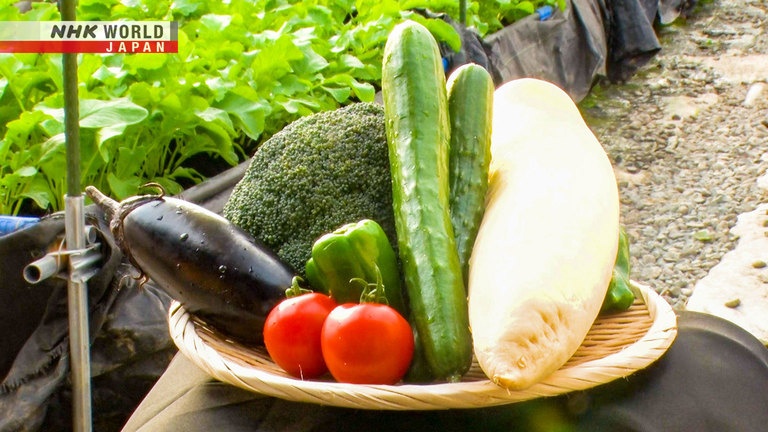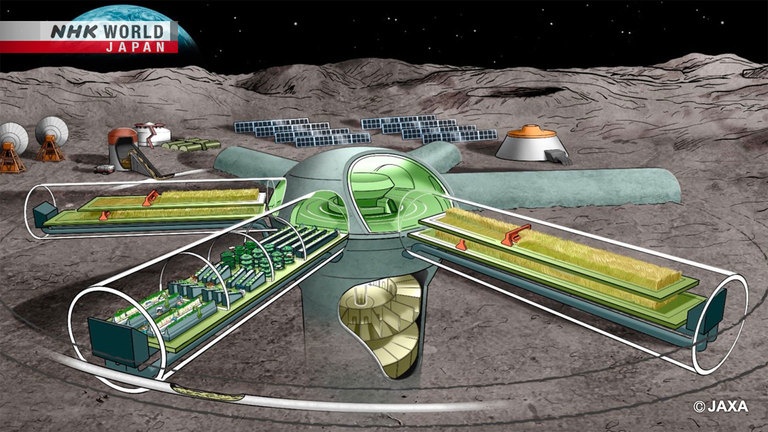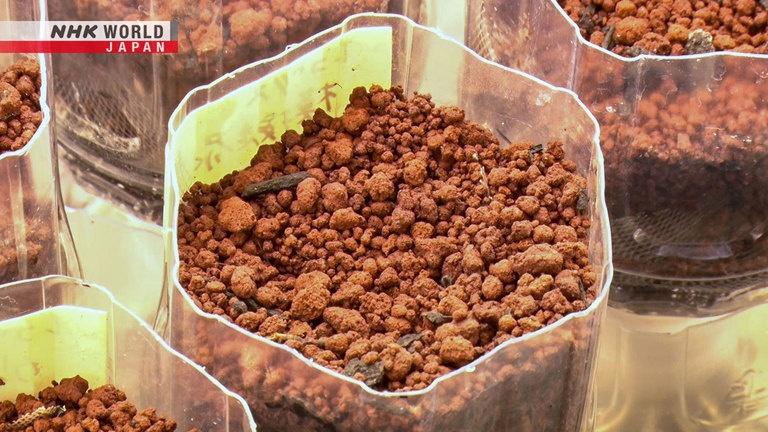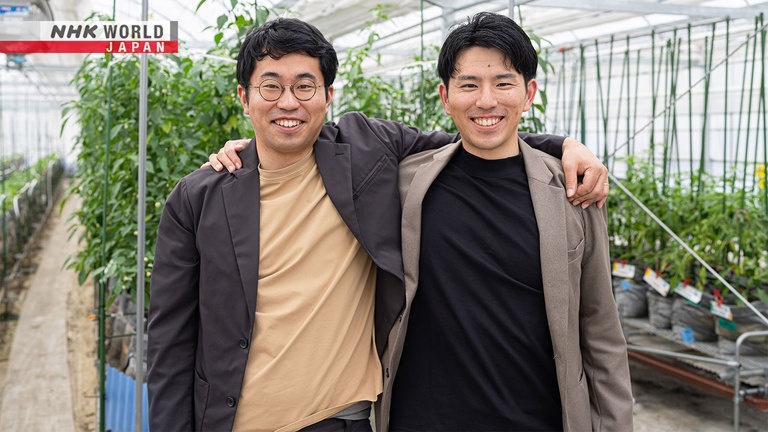Artificial High-Performance Soil: Shaping the Future of Agriculture
Preparing soil for organic farming takes years, but a new Japanese technology does it in 1 month. Discover how it's opening doors to lunar farming.




Transcript
Kakogawa City, Hyogo Prefecture.
This soil could be the champion.
This broccoli field was started 2 years ago,
after purchasing the land that had once been a rice paddy.
The soil was heavy clay,
unsuitable for growing vegetables.
The broccoli were
far from professional quality
and more like home gardening.
What was the secret to growing healthy vegetables in clay soil?
It was the transition to organic farming.
Moreover, a certain type of artificial soil had been mixed in,
to change the property of the original soil.
Today, the mainstream method of farming uses chemical fertilizers.
They are used in approximately 98% of the world's farmlands.
However, in recent years, countries some countries, have begun to move towards organic farming,
which does not use chemical fertilizers.
One of the main reasons behind this is...
Russia's invasion of Ukraine that started in 2022.
It has caused worldwide disruption in the distribution of raw materials for chemical fertilizers.
Furthermore, the price of natural gas used in its production rose sharply,
almost doubling the price of chemical fertilizers in one year.
Agriculture in Japan was especially hit hard,
because it relies on imports for raw materials used in fertilizer production.
Moreover, with the global trend towards decarbonization,
there is a growing movement to reduce the use of chemical fertilizers, which emit CO2 during its production.
The Japanese government has also begun efforts to increase the amount of organic farmland.
However, the transition to organic farming requires considerable time and effort.
It is said to take 3 to 5 years to create soil that can supply nutrients to crops
without relying on chemical fertilizers.
For this reason, the area of organic farmland in Japan as of 2020,
still remained at 0.6% of the total agricultural land.
As a solution to this problem, the technology that is attracting attention is...
Artificial high-performance soil developed by a Japanese company!
This artificial soil is about to revolutionize conventional farming!
What is remarkable is the speed in which fertile land is produced.
With the high-performance soil, soil for organic farming can be prepared in as little as one month.
Some experiments have shown that crop yields exceed that of farming using chemical fertilizers.
This technology has also attracted the attention of NASA
for its ability to transform land unsuitable for cultivation to fertile land.
Currently, research is underway to grow vegetables on the moon.
Each failure is bringing us
one step closer to success.
How was this incredible artificial fertilizer created?
We'll dig deep into the cutting-edge research that is shaping the future of agriculture.
Aichi Prefecture is known for its relatively mild year-round climate and for its abundant water resources.
We visited a plastic greenhouse in Kariya City.
This is the high-performance soil.
Conducting experiments with the soil is the developer, NISHIDA Kohei.
This greenhouse is an experimental farm.
About 15 types of vegetables are grown using high-performance soil.
Controlled experiments are conducted in various environmental conditions
by altering factors such as temperature and humidity.
By the way, why is the soil so black?
These are the raw materials
for high-performance soil.
They include biochar made by carbonizing
rice husks and coffee residue.
We make it by heating things that
would have been thrown away.
The raw material for high-performance soil is biochar,
produced by burning plants and other organic matter.
Using biochar can significantly reduce CO2 emissions from farming.
For example, when rice husks are added to soil in their raw state,
they are broken down by bacteria and will emit CO2 few months later.
However, biochar cannot be broken down even by bacteria.
That is because charcoal is made almost entirely of carbon,
and thus, it is difficult for it to transform into other materials.
It is said that biochar will not emit CO2 even after 100 years.
Biochar is spread over the farmland along with manure and other organic fertilizers.
Crop seeds are then planted and watered for cultivation.
Crop yield is also said to be 20% higher than using chemical fertilizers.
How did this artificial soil, created from burnt waste, turn out to perform so well?
When you magnify the surface of the biochar...
you will see countless holes.
Nishida says the secret lies in these holes.
What makes this biochar unique is
there are microbes living inside the holes.
They help the biochar perform well.
The secret behind the high-performance soil was the microorganisms living inside the holes of the biochar.
Microorganisms are, in fact, so vital it can be said that they play a central role in organic farming.
There are 3 main nutrients for plants: nitrogen, phosphorus and potassium.
Among them, nitrogen has a major impact on plant growth.
However, plants cannot use nitrogen directly as a nutrient.
This is where microorganisms come into play.
In nature, there are bacteria and fungi that convert nitrogen into other substances.
Nitrogen is turned into ammonium ion by one type of microorganism,
and then converted into nitrate ion by another.
Plants absorb these nutrients through their roots.
Grown plants are eaten by animals and undergo further transformations into other substances.
After going through several processes, they eventually return to nitrogen.
In other words, organic agriculture is the cultivation of crops that utilizes
the nutrient cycling of nitrogen with the help of microorganisms.
So instead of the 3 to 5 years it normally takes to create this cycle in the soil...
the high-performance soil can shorten this time to one month.
How is that possible?
The key is mixing various microbes
in different combinations
to make a microbial cocktail.
By introducing microorganisms of various combinations into biochar,
they are able to dramatically improve the efficiency.
What exactly does this mean?
To find out, we visited the School of Science at Nagoya University.
At this laboratory, they make microbial cocktail and experiment with various combinations
to see how they react when they are added to biochar.
Conducting this research is NISHIDA Ryoya.
He is the younger brother of NISHIDA Kohei, that showed us the experimental farm.
Ryoya is also the technical director of the company that developed the high-performance soil.
We define microbial cocktail as a collection of bacteria
that can achieve the targeted results.
A microbial cocktail is a mix of various microorganisms cultured in various combinations.
Soil differs from place to place.
They are not all the same.
The microorganisms that inhabit the soil are also diverse.
It is said that there are as many as 320 different types of soil throughout Japan.
To improve soil efficiency using high-performance soil,
it is essential to determine the optimal combination of microorganisms
as well as the appropriate amount for each farmland.
For instance, clay soil has the characteristics to hold water and does not allow air to penetrate easily.
This is due to the small size of the soil particles and their high density,
resulting in narrow gaps between the particles.
If one tries to grow plants in such soil,
the roots will be exposed to too much water, causing them to rot.
To solve this problem, this is the combination of microbes.
When these microbes team up, they produce a network of threads called mycelium,
which binds the particles together to form clumps.
The particles gradually become bigger, causing the narrow gaps to widen.
This is how the flow path for water is created.
The soil now has better drainage and plant roots will be less prone to rot, even in clay soil.
Ryoya's research investigates the combination of microorganisms needed to improve different soil.
When this research first began, researchers were just starting to understand how the different microbes work in the soil
and how they interact with each other.
That's why, creating microbial cocktails was a trial-and-error process,
and initially, it was a series of failures.
One of the biggest challenges was figuring out a way for microbes that produce ammonium ions
and those that produce nitrate ions to work well in parallel.
It's crucial to create and maintain
a good environment for the targeted microbes.
When things go wrong, it leads to rotting,
causing a pungent smell.
Then, we have to deal with fly infestation.
Microbes that do not work well in parallel, may break down nitrogen into ammonium ions,
but no further changes occur, leaving only ammonium ions to accumulate in the soil.
With too much ammonium ions in the soil, plants begin to rot.
As a result, it leads to a rotting smell and fly infestation.
The goal was to have the target microorganisms work well simultaneously.
This was one of the biggest challenges.
The breakthrough idea came from a certain traditional Japanese drink.
It's very similar to how sake is made.
Two stages of reaction occur in a single tank.
Starch is converted into sugar
and sugar is converted into alcohol.
Sake is made using the balanced workings of microbes
that convert starch into sugar and those that convert sugar into alcohol.
This process is called "multiple parallel fermentation."
By adjusting the temperature to accommodate the microbes and introducing the right amount of organic fertilizer at the right timing,
Ryoya was able to create conditions, where the microbes could do their job without interfering with each other.
By ensuring that only a specific type of microbe was active at each stage,
while making sure the other was not eliminated, he was able to create an environment where nutrition could be produced efficiently.
Our soil was becoming ready
for farmers to try out.
Finally, we were able to make products
that were practical.
The high-performance soil was ready to be tested in real-world applications.
However, when the brothers went to talk to farmers about using the high-performance soil they've developed, very few showed interest.
We went to about 100 farmers,
but only 3 bothered to listen.
And those 3 had their own ideas,
and so we just listened to them.
They weren't interested in our product.
The Nishida brothers had no choice but to start their own farm.
They began growing crops using high-performance soil.
But since it's our own farm, we can conduct
experiments that have risk and collect data.
We're good at trial and error.
We can repeat experiments on our farm.
The brothers carefully adjusted the conditions for the microbial cocktail
by using different ratios of high-performance soil, regular soil, and organic fertilizers.
Through trial and error, they determined which high-performance soil best suited each crop.
Their earnest efforts to improve farming practices began to win the hearts of those around them.
Farmers eventually started offering their support.
I'm glad I made the decision
to just go for it.
I believe this is truly revolutionary.
This year, we have about 100 farmers
using our soil.
Some want to use it next spring
or expand their area.
We're preparing to make sure
it'll be available.
By communicating with their staff,
the brothers are putting their efforts to create biochar tailored to each farmer's needs.
Meanwhile, the global trend in agriculture began to work in their favor.
The world was steering away from relying on chemical fertilizers and transitioning towards organic farming.
Efforts are being made worldwide
to shift to organic farming.
But if it's not done properly,
the crops won't grow well.
We are trying to develop soil
that helps farmers make the shift.
We're from Shigaraki Town in Shiga Prefecture
where the stars are beautiful.
Kohei and Ryoya's grandparents ran a farm in Shiga Prefecture.
The boys grew up eating freshly picked vegetables and always remembered how good they tasted.
It had been their hope to give something back to agriculture one day.
However, the two learned of the various problems that agriculture can cause, such as environmental pollution.
Eventually, they came to think that...
Doing things the conventional way won't help give back to agriculture.
In order to help agriculture advance in new ways,
the two decided to study in different fields in college.
Kohei, went to the Department of Environmental Studies to focus on the future of agriculture.
Ryoya, entered the Department of Engineering to study soil improvement.
Applying knowledge from their respective research, they developed the high-performance soil.
And in 2020, they decided to launch a business together.
Currently, more and more farmers are starting to adopt their high-performance soil.
Now, this technology is moving up to the next level.
White smoke is rising from the launch pad.
And liftoff of the spacecraft.
The spacecraft is ascending smoothly.
Currently, the Artemis Program is being led by NASA.
Its goal is to establish a permanent base on the moon's surface or its vicinity.
With an eye towards future manned exploration of Mars,
plans are underway to land a man on the moon after 2025 as a first step toward this goal.
However, there is an inevitable challenge: securing food in space.
It's estimated to cost over 100 million yen
to send 1kg of supplies to the moon.
To live on the moon, they need to
grow food using what's available.
Currently, long-term habitation is impractical.
To be self-sufficient through organic farming, it's essential to produce fertile soil,
rather than relying on chemical fertilizers which come with a huge shipping cost.
And this is also true in space.
In addition to improving soil on their farmland, the brothers launched a space agriculture project in 2022.
Their company has now joined JAXA's working group which is a part of the Artemis Program.
The ultimate goal is to establish a farm on the lunar surface
using artificial soil and achieve food self-sufficiency on the moon.
I'm super excited!
We're going to make this happen!
As a matter of fact, the Nishida brothers are huge space enthusiasts.
In their childhood, the boys became hooked on the manga series called "Space Brothers."
Ever since then, they became fascinated with the idea of one day working with the space industry.
Currently, their research is making steady progress.
Now, they've brought back
samples of lunar soil.
And it's being replicated
for research purposes.
Sand from the moon, or lunar regolith,
is made up of fine particles that make it difficult for microorganisms to thrive.
In other words, it's challenging to produce nutrients necessary for plant growth.
The Nishida brothers added microorganisms into replicated soil
made by another company taking part in JAXA's project.
Research is underway to turn it into fertile soil suitable for plant cultivation.
In 2022, they succeeded in growing komatsuna, Japanese mustard spinach, in this soil.
We're now doing experiments on Earth, but
we want to try out our system in space in the future.
As the global population increases,
there is the issue of food production.
People could die from hunger.
By using our scientific knowledge,
we want to contribute to the solution.
In their childhood, the Nishida brothers became fascinated
by space through the manga "Space Brothers."
Now, the real-life Space Brothers have a vision to create highly efficient
and sustainable farming anywhere...from your patio to outer space.
The future of space farming lies in a completely new and innovative style of organic agriculture.
This technology is about to open the doors to a new frontier.